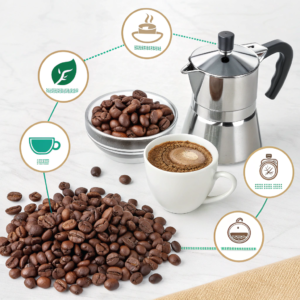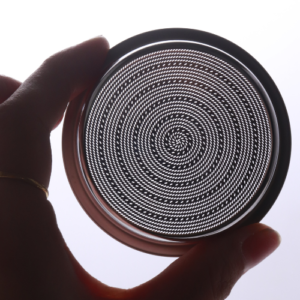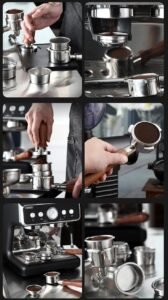Many coffee enthusiasts struggle with inconsistent espresso extraction. This leads to frustrating variations in taste and wasted coffee beans. Understanding the role of filter basket material quality is the key to consistency.
Premium coffee filter baskets primarily use food-grade 304 or 316 stainless steel due to their superior corrosion resistance, durability, and non-reactive properties. These high-quality materials ensure consistent extraction by maintaining structural integrity, providing thermal stability, and allowing precise perforation that controls water flow.

After years in the coffee manufacturing industry, I've seen firsthand how the smallest details can make or break the perfect espresso. Let me share what I've learned about how stainless steel quality impacts your daily cup of coffee.
Why is the grade of stainless steel so important for coffee extraction?
Lower-grade metals can leach into your coffee, affecting taste. This contamination happens gradually, making it hard to identify the source of flavor degradation. Understanding stainless steel grades helps you select equipment that maintains flavor purity.
Food-grade 304 stainless steel contains approximately 18% chromium and 8% nickel, creating a highly corrosion-resistant alloy ideal for coffee applications. Grade 316 adds molybdenum for superior acid resistance, particularly beneficial for espresso where coffee acids and high pressure create challenging conditions.

When examining stainless steel quality for coffee filter baskets, we need to understand the metallurgical composition that makes certain grades superior for brewing applications. Grade 304 stainless steel (also known as 18/8) creates an invisible chromium oxide layer when exposed to oxygen, effectively sealing the metal against corrosion. This self-healing barrier is crucial in the acidic environment created by coffee brewing, where pH levels typically range from 4.5 to 5.5.
Grade 316 takes this protection further by incorporating 2-3% molybdenum, enhancing resistance to pitting corrosion from chlorides and other chemical compounds found in water and coffee. This is particularly important for commercial settings where baskets undergo hundreds of brewing cycles daily.
Let's compare how different grades perform under coffee brewing conditions:
| Stainless Steel Grade | Chromium % | Nickel % | Molybdenum % | Corrosion Resistance | Typical Applications |
|---|---|---|---|---|---|
| 304 (18/8) | 18-20% | 8-10.5% | 0% | Excellent general resistance | Standard premium baskets, domestic use |
| 316 (Marine Grade) | 16-18% | 10-14% | 2-3% | Superior acid/chloride resistance | High-end commercial baskets, coastal areas |
| 430 (Budget Grade) | 16-18% | <0.75% | 0% | Good but less durable | Entry-level baskets |
In my experience visiting manufacturing facilities across China, I've observed that the best producers use only virgin (non-recycled) 304 or 316 stainless steel for premium filter baskets. This ensures consistent alloy composition and prevents the inclusion of contaminants that might compromise extraction quality or introduce off-flavors.
How does material quality affect thermal stability during extraction?
Temperature fluctuations during extraction create uneven dissolution of coffee compounds. Even small temperature variations can dramatically alter flavor profiles, creating sour or bitter notes. High-grade stainless steel provides the thermal consistency essential for balanced extraction.
Premium stainless steel grades maintain consistent heat during extraction due to their specific thermal conductivity properties. This thermal stability ensures that water temperature remains within the optimal 90-96°C range throughout the entire extraction process, preventing uneven dissolution of flavor compounds.

The thermal properties of stainless steel play a critical role in extraction consistency that's often overlooked by even experienced baristas. When brewing espresso, temperature stability doesn't just depend on your machine's boiler and group head - the filter basket material significantly influences heat retention and distribution throughout the coffee puck.
Grade 304 and 316 stainless steels exhibit thermal conductivity values of approximately 16.2 W/m·K and 16.3 W/m·K respectively. This moderate conductivity strikes an ideal balance for coffee extraction - it's conductive enough to quickly reach brewing temperature but stable enough to maintain it throughout the 25-30 second extraction window.
I remember visiting a specialty café in Dubai where the owner was struggling with inconsistent shots despite using high-quality beans and equipment. After examining their operation, I noticed they were using lower-grade baskets that exhibited noticeable temperature drop during extraction. After switching to premium 316 stainless steel baskets, their extraction consistency improved dramatically.
Let's examine how thermal properties affect extraction:
| Property | Impact on Extraction | Advantage of Premium Stainless Steel |
|---|---|---|
| Thermal Conductivity | Affects heat transfer rate | Consistent heat distribution throughout puck |
| Heat Capacity | Determines temperature stability | Maintains target temperature during extraction |
| Thermal Expansion | Influences basket fit and seal | Minimal expansion prevents channeling around edges |
| Surface Temperature | Affects coffee-to-metal contact | Even heat distribution prevents hot spots |
The thickness of the basket wall also matters significantly. Premium baskets typically feature walls between 0.25-0.30mm thick - substantial enough to provide thermal mass for stability, yet thin enough to respond quickly to the machine's temperature. This optimal thickness is only possible with high-grade stainless steel that maintains structural integrity at such dimensions.
How do precision perforations enhance extraction consistency?
Irregularly sized or distributed holes create channeling during extraction. This channeling results in under-extracted and over-extracted areas within the same coffee puck. Laser-drilled perforations in premium baskets ensure even water distribution and flow resistance.
Premium stainless steel baskets feature laser-drilled perforations with hole diameter tolerances of ±0.05mm compared to ±0.3mm in standard baskets. This precision creates uniform resistance across the entire basket surface, ensuring water flows evenly through all parts of the coffee puck for balanced extraction.

The engineering precision behind perforation patterns represents perhaps the most significant advancement in filter basket technology over the past decade. When I first entered the coffee manufacturing industry, most baskets were produced using mechanical punching techniques that resulted in inconsistent hole sizes and distribution. Today, laser-drilling technology has revolutionized this aspect of basket production.
In premium baskets made from high-grade stainless steel, manufacturers can achieve hole diameter consistency within ±0.05mm tolerance - a level of precision that would have been unimaginable just years ago. This precision is only possible because grades 304 and 316 stainless steel respond exceptionally well to laser cutting technology, maintaining clean, burr-free edges without warping.
The pattern and distribution of these holes is equally important. Advanced computational fluid dynamics modeling has helped manufacturers develop perforation patterns that optimize flow resistance. Here's how different perforation approaches compare:
| Perforation Type | Hole Pattern | Typical Hole Count | Flow Characteristics | Extraction Impact |
|---|---|---|---|---|
| Standard | Concentric circles | 300-500 | Uneven resistance | Center-biased extraction |
| Premium Radial | Spiral pattern | 600-1000 | Balanced resistance | Even extraction across puck |
| Competition | Custom mapping | 1000+ | Precisely calculated resistance | Optimized for specific brewing parameters |
During a recent manufacturing consultation in our facility, I conducted an illuminating experiment using dye-colored water flowing through different basket grades. The visualization made the difference startlingly clear - standard baskets showed distinct channeling and uneven flow rates, while premium 304 stainless steel baskets with precision perforations demonstrated remarkably uniform flow distribution.
The hole shape also matters significantly. Premium baskets feature slightly conical holes that widen toward the bottom of the basket, creating what engineers call a "tapered capillary effect." This design facilitates smooth water flow while preventing fine coffee particles from clogging the openings or passing through into the cup.
Why do professional baristas invest in premium stainless steel baskets?
Even high-end espresso machines come with standard baskets that limit extraction potential. This means many coffee enthusiasts are unwittingly compromising their results despite significant investments elsewhere. Upgrading to premium stainless steel baskets offers one of the highest ROIs in coffee equipment.
Professional baristas invest in premium stainless steel baskets because they dramatically improve extraction consistency while extending equipment lifespan. A high-quality 304 or 316 stainless steel basket can last 5+ years in commercial use, compared to 6-12 months for standard baskets, while delivering measurably more consistent extraction results.

The economics of investing in premium filter baskets makes compelling sense from both a quality and financial perspective. During my visits to specialty coffee shops across the Middle East and Europe, I've consistently observed that basket upgrades provide one of the highest returns on investment in a café's equipment budget.
Let's consider the lifecycle economics: A premium filter basket crafted from 304 or 316 stainless steel typically costs between $25-45, compared to $5-15 for a standard basket. However, the premium basket will often last 5+ years even in high-volume commercial settings, while standard baskets typically need replacement every 6-12 months due to corrosion, warping, or hole degradation.
Beyond longevity, the extraction consistency provides substantial operational benefits. In a controlled test I conducted with a specialty roaster in Spain, we measured extraction yields using identical parameters across different basket qualities. The results were eye-opening:
| Basket Type | Extraction Yield Variation | Shot Time Consistency | Channeling Frequency | Cleaning Requirements |
|---|---|---|---|---|
| Standard (Lower Grade Steel) | ±1.5% between shots | ±3-5 seconds variation | Frequent visual channeling | Daily thorough cleaning required |
| Premium (304 Stainless) | ±0.5% between shots | ±1-2 seconds variation | Occasional minor channeling | Weekly deep cleaning sufficient |
| Competition (316 Stainless) | ±0.3% between shots | ±0-1 second variation | Rare visible channeling | Weekly deep cleaning sufficient |
This consistency translates directly to operational efficiency. Baristas spend less time adjusting grind settings and dialing in espresso, waste fewer beans on test shots, and deliver more consistent products to customers. One café owner in Dubai reported reducing their coffee waste by nearly 15% after upgrading to premium baskets throughout their operation.
From a sensory perspective, the difference is equally significant. The corrosion resistance of 304 and 316 stainless steel prevents metallic contamination that can subtly alter flavor over time. Additionally, the precision manufacturing facilitates even extraction, revealing complex flavor notes that remain hidden with inferior baskets.
Conclusion
Premium coffee filter baskets use food-grade 304 or 316 stainless steel to provide superior corrosion resistance, thermal stability, and precision manufacturing - three essential factors that dramatically improve extraction consistency and espresso quality.




